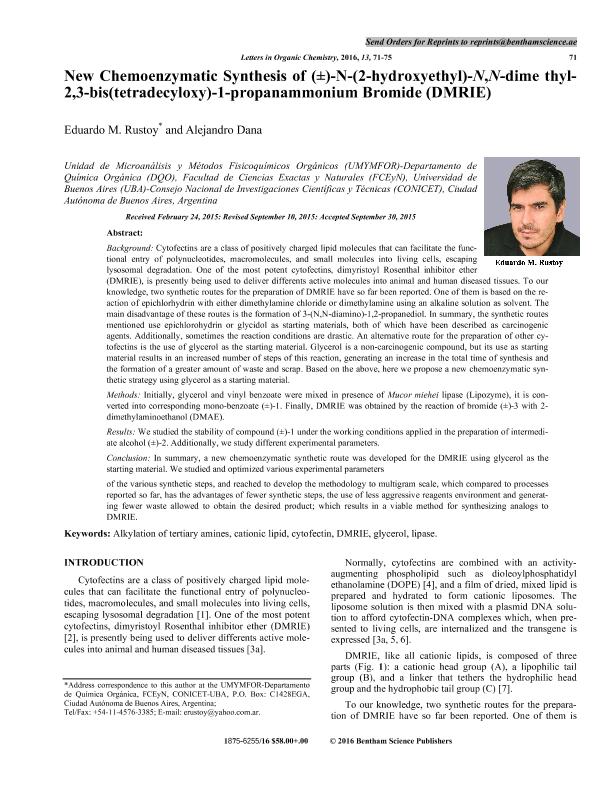Mostrar el registro sencillo del ítem
dc.contributor.author
Rustoy, Eduardo Miguel

dc.contributor.author
Dana, Alejandro Leonel

dc.date.available
2017-06-22T20:24:55Z
dc.date.issued
2015-12
dc.identifier.citation
Rustoy, Eduardo Miguel; Dana, Alejandro Leonel; New Chemoenzymatic Synthesis of (±)-N-(2-hydroxyethyl)-N,N-dime thyl- 2,3-bis(tetradecyloxy)-1-propanammonium Bromide (DMRIE); Bentham Science Publishers; Letters In Organic Chemistry; 13; 1; 12-2015; 71-75
dc.identifier.issn
1570-1786
dc.identifier.uri
http://hdl.handle.net/11336/18712
dc.description.abstract
Background: Cytofectins are a class of positively charged lipid molecules that can facilitate the functional entry of polynucleotides, macromolecules, and small molecules into living cells, escaping lysosomal degradation. One of the most potent cytofectins, dimyristoyl Rosenthal inhibitor ether (DMRIE), is presently being used to deliver differents active molecules into animal and human diseased tissues. To our knowledge, two synthetic routes for the preparation of DMRIE have so far been reported. One of them is based on the reaction of epichlorhydrin with either dimethylamine chloride or dimethylamine using an alkaline solution as solvent. The main disadvantage of these routes is the formation of 3-(N,N-diamino)-1,2-propanediol. In summary, the synthetic routes mentioned use epichlorohydrin or glycidol as starting materials, both of which have been described as carcinogenic agents. Additionally, sometimes the reaction conditions are drastic. An alternative route for the preparation of other cytofectins is the use of glycerol as the starting material. Glycerol is a non-carcinogenic compound, but its use as starting material results in an increased number of steps of this reaction, generating an increase in the total time of synthesis and the formation of a greater amount of waste and scrap. Based on the above, here we propose a new chemoenzymatic synthetic strategy using glycerol as a starting material. Methods: Initially, glycerol and vinyl benzoate were mixed in presence of Mucor miehei lipase (Lipozyme), it is converted into corresponding mono-benzoate (±)-1. Finally, DMRIE was obtained by the reaction of bromide (±)-3 with 2- dimethylaminoethanol (DMAE). Results: We studied the stability of compound (±)-1 under the working conditions applied in the preparation of intermediate alcohol (±)-2. Additionally, we study different experimental parameters. Conclusion: In summary, a new chemoenzymatic synthetic route was developed for the DMRIE using glycerol as the starting material. We studied and optimized various experimental parameters of the various synthetic steps, and reached to develop the methodology to multigram scale, which compared to processes reported so far, has the advantages of fewer synthetic steps, the use of less aggressive reagents environment and generating fewer waste allowed to obtain the desired product; which results in a viable method for synthesizing analogs to DMRIE.
dc.format
application/pdf
dc.language.iso
eng
dc.publisher
Bentham Science Publishers

dc.rights
info:eu-repo/semantics/openAccess
dc.rights.uri
https://creativecommons.org/licenses/by-nc-sa/2.5/ar/
dc.subject
Alkylation of Tertiary Amines
dc.subject
Cytofectin
dc.subject
Dmrie
dc.subject
Lipase
dc.subject.classification
Química Orgánica

dc.subject.classification
Ciencias Químicas

dc.subject.classification
CIENCIAS NATURALES Y EXACTAS

dc.title
New Chemoenzymatic Synthesis of (±)-N-(2-hydroxyethyl)-N,N-dime thyl- 2,3-bis(tetradecyloxy)-1-propanammonium Bromide (DMRIE)
dc.type
info:eu-repo/semantics/article
dc.type
info:ar-repo/semantics/artículo
dc.type
info:eu-repo/semantics/publishedVersion
dc.date.updated
2017-06-22T17:38:26Z
dc.identifier.eissn
1875-6255
dc.journal.volume
13
dc.journal.number
1
dc.journal.pagination
71-75
dc.journal.pais
Emiratos Árabes Unidos

dc.journal.ciudad
Sharjah
dc.description.fil
Fil: Rustoy, Eduardo Miguel. Consejo Nacional de Investigaciones Científicas y Técnicas. Oficina de Coordinación Administrativa Ciudad Universitaria. Unidad de Microanálisis y Métodos Físicos en Química Orgánica. Universidad de Buenos Aires. Facultad de Ciencias Exactas y Naturales. Unidad de Microanálisis y Métodos Físicos en Química Orgánica; Argentina
dc.description.fil
Fil: Dana, Alejandro Leonel. Consejo Nacional de Investigaciones Científicas y Técnicas. Oficina de Coordinación Administrativa Ciudad Universitaria. Unidad de Microanálisis y Métodos Físicos en Química Orgánica. Universidad de Buenos Aires. Facultad de Ciencias Exactas y Naturales. Unidad de Microanálisis y Métodos Físicos en Química Orgánica; Argentina
dc.journal.title
Letters In Organic Chemistry

dc.relation.alternativeid
info:eu-repo/semantics/altIdentifier/doi/http://dx.doi.org/10.2174/1570178612666150930222411
dc.relation.alternativeid
info:eu-repo/semantics/altIdentifier/url/http://www.eurekaselect.com/135371/article
Archivos asociados
